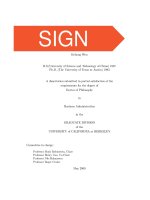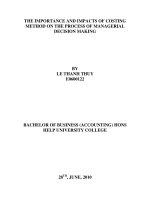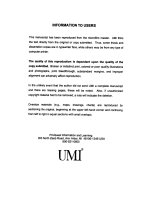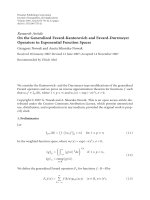research method topic the pleasure and fulfillment that customers experience when utilizing the services offered by the vinpearl hotel chain
Bạn đang xem bản rút gọn của tài liệu. Xem và tải ngay bản đầy đủ của tài liệu tại đây (3.44 MB, 75 trang )
<span class="text_page_counter">Trang 1</span><div class="page_container" data-page="1">
<b>VIET NAM GENERAL CONFEDRATION OF LABOR TON DUC THANG UNIVERSITY </b>
<b>FACULTY OF BUSINESS ADMITRATION </b>
<b>RESEARCH METHOD </b>
<b>Topic: The pleasure and fulfillment that customers experience when utilizing the services offered by the </b>
<b>Vinpearl hotel chain. </b>
<b>Instructor: TRAN THI VAN TRANG Group: Phuc Long </b>
<b>Ho Chi Minh, March 2023 </b>
</div><span class="text_page_counter">Trang 2</span><div class="page_container" data-page="2"><b>VIET NAM GENERAL CONFEDRATION OF LABOR TON DUC THANG UNIVERSITY </b>
<b>FACULTY OF BUSINESS ADMITRATION </b>
<b>RESEARCH METHOD </b>
<b>Topic: The pleasure and fulfillment that customers experience when utilizing the services offered by the </b>
<b>Vinpearl hotel chain. </b>
<b>Instructor: TRAN THI VAN TRANG Group: Phuc Long </b>
<b>Ho Chi Minh, March 2023 </b>
</div><span class="text_page_counter">Trang 3</span><div class="page_container" data-page="3">• Chapter 5 (5.1, 5.2) • Run SmartPLS 4 • Design and collect
questionaire form • Powerpoint and presentation
100%
<b>3 </b> Pham Hoang
• Chapter 1 (1.2, 1.3, 1.5) • Chapter 2 (2.2.2, 2.3.1, 2.2.3) • Chapter 3 (3.3, 3.4) • Chapter 4 (4.1, 4.2) • Chapter 5 (5.3, 5.4) • Presentation
100%
</div><span class="text_page_counter">Trang 4</span><div class="page_container" data-page="4"><b>COMMENTS FROM LECTURERS </b>
</div><span class="text_page_counter">Trang 5</span><div class="page_container" data-page="5"><b>ACKNOWLEDGMENTS </b>
First of all, we would like to express our deepest and most sincere thanks to the instructor who guided our – Mrs. Tran Thi Van Trang – Lecturer of Faculty of Business Administration, Ton Duc Thang University for wholeheartedly guiding our through the learning process as well as giving suggestions and creating the best conditions in completing the report.
Secondly, our team would like to express our sincere gratitude to the Faculty of Business Administration at Ton Duc Thang University for providing us with the opportunity to study and research this subject. The Faculty has been incredibly supportive, sharing their expertise and knowledge of referencing documents, which has not only been useful in carrying out and completing our research project, but also in our overall learning and practical experiences at Ton Duc Thang University.
Thirdly, we would like to thank our teachers for their guidance, help, and the knowledge they have imparted upon us during this project. Despite the challenges of online learning with a new teaching method, we were able to complete our research project thanks to their support. Additionally, we would like to express our gratitude to our team members who have worked together to accomplish this study.
Finally, we would like to extend our sincerest wishes to our teachers and friends, who have continuously supported and cared for us throughout our academic journey. We hope that they are always healthy and at peace. Our team is grateful for their kindness and wishes to express our thanks once again.
</div><span class="text_page_counter">Trang 6</span><div class="page_container" data-page="6"><b>DECLARATION OF AUTHORSHIP THE THESIS HAS BEEN ACCOMPLISHED AT TON DUC THANG UNIVERSITY </b>
We hereby declare that our report is our own work under the guidance and guidance of MBA. Tran Thi Van Trang; and that the work and the results contained therein are original and have never been sent anywhere for any purpose. The figures and figures presented in this report are the analysis, comments and assessments from various sources made by ourself and have been fully recorded in the reference section.
In addition, comments, reviews and other data used by other authors and organizations have been clearly recorded and cited.
We will take full responsibility for any fraud discovered in our report. Ton Duc Thang University is not involved in any copyright infringement of my work (if any).
Author
</div><span class="text_page_counter">Trang 7</span><div class="page_container" data-page="7"><b>ABSTRACT </b>
The present research study proposes an integrated model that aims to examine the influence of several constructs, namely, customer brand identification, affective commitment, customer satisfaction, and brand trust, on the customer behavioral intention of loyalty within the hospitality industry. This research combines social identity theory and relationship marketing theory. The data for this research was collected through a survey administered to 345 customers who stayed at Vinpearl’s hotel chains. Confirmatory factor analysis was utilized to analyze the data, followed by structural equation modeling. The findings suggest that customer brand identification has a direct impact on customer behavior intention of loyalty and is also mediated by affective commitment, customer satisfaction, and brand trust. Additionally, the latter three constructs have a direct influence on customer behavior intention of loyalty, and the impact of customer satisfaction and brand trust on customer behavior intention of loyalty is also mediated by affective commitment. These results have not been extensively explored in the marketing field, particularly in the hospitality research domain. Further exploration of these relationships can potentially advance the field.
<b>Keywords</b>: customers behavior, hospitality industry, hospitality management, consumers preferences, economy
</div><span class="text_page_counter">Trang 8</span><div class="page_container" data-page="8"><b>LIST OF ABBREVIATIONS AND ACRONYMS </b>
<b>PLS-SEM </b> Partial Least Square - Structural Equation Modeling
<b>CBIL </b> Customer Behavioral Intention of Loyalty
</div><span class="text_page_counter">Trang 9</span><div class="page_container" data-page="9"><b>LIST OF FIGURES </b>
Figure 2.1 Theoretical framework ... 14Figure 2.2 Research framework ... 15Figure 2.3 Conceptual model ... 16
</div><span class="text_page_counter">Trang 10</span><div class="page_container" data-page="10"><b>LIST OF TABLES </b>
Table 3.1 Questionairy design... 26
Table 3.2 Parameters of variables in SmartPls 4 ... 31
Table 4.1 Respondent Demographics ... 32
Table 4.2 Conformity results of factors ... 32
Table 4.3 Outer loading, VIF, AVE and Composite Reliability (Smart PLS 4.0) ... 36
Table 4.4 Fornell and Larcker criterion ... 39
Table 4.5 Heterotrait – Monotrait ratio test ... 39
Table 4.6 Model fit ... 40
Table 4.7 R-Square result ... 41
Table 4.8 Hypotheses testing ... 42
</div><span class="text_page_counter">Trang 11</span><div class="page_container" data-page="11"><b>2.2 Concepts and theories: ... 8 </b>
2.2.1 Customer Brand Identification (CBI) ... 9
2.2.2 Customer Brand Identification of Loyalty (CBIL) ... 9
</div><span class="text_page_counter">Trang 12</span><div class="page_container" data-page="12"><b>3.7 Data analysis method ... 30 </b>
<b>CHAPTER 4. DATA ANALYSIS ... 32 </b>
<b>4.1 Respondent demographics: ... 32 </b>
<b>4.2 Measurement model ... 33 </b>
4.2.1. Indicator Reliability ... 33
4.2.2 Internal Consistency Reliability ... 36
<b>4.2.3 Variance Inflation Factor ... 37 </b>
</div><span class="text_page_counter">Trang 14</span><div class="page_container" data-page="14">As a major player in the tourism industry, the hospitality sector contributes greatly to the success of tourism in a country. In terms of contribution to the overall economy, the service industry recovered and expanded strongly, reaching a growth rate of 9.99% in 2022, the highest rate since 2011.
The tourism and hospitality industry has grown steadily over time and emerged as the world's largest service sector profit earner. Every nation strives to capture the tourism market by providing superior tourism products and/or services due to the industry's fierce competition. In addition, traveling has become more convenient and cost-effective as a result of revolutionary industry shifts like the rise of low-cost airlines and online platforms for lodging reservations. Since 2021, Vietnam has become one of the most appealing destination and reached 6th place in Southeast Asia. In recent years, new high-end hotels have been built as a result of the rising number of tourists visiting Vietnam. With the advantage of scenery and culture, Vietnam is always an attractive destination for tourists. The development of the tourism industry thereby promotes the growth of the hospitality industry.
The COVID-19 outbreak has caused a lot of damage to Vietnam's tourism industry. The pandemic forced the closure of the country, the refusal of
international travel. While domestic travel is still allowed, the outbreak of
</div><span class="text_page_counter">Trang 15</span><div class="page_container" data-page="15">COVID-2
19 is still limiting travel throughout Vietnam. Companies and businesses operating in the tourism sector suffered large losses and some closed; restaurants and hotels also had to shut down.
According to the World Tourism & Travel Council (WTTC), in 2020-2021 alone, the pandemic caused the loss of 62 out of a total of 334 million jobs in the tourism industry. According to a report of the Hanoi Department of Tourism, in 2021, about 1,550 accommodation establishments suspended operations and changed industries; Along with about 21,500 workers in the tourism industry who had to suspend their jobs, accounting for 34% of the total number of employees serving in the accommodation sector, 11,600 workers terminated labor contracts, accounting for about 18.3%. Across most provinces in the country, it is also common for tourism workers to quit their jobs to find new jobs. (dangcongsan.vn)
And according to statistics of the Vietnam National Administration of Tourism, revenue of accommodation and catering services in the first quarter of 2020 decreased by 9.6% compared to the same period last year. In which the City. Ho Chi Minh City, Da Nang, Hanoi... all reduced from 15% to 30% of revenue.
The Covid-19 pandemic in 2020 has had a strong impact on the Vietnamese economy, in which, the tourism industry is heavily affected. Flight bans, travel restrictions and the apprehension of tourists due to fear of the impact of the Covid-19 epidemic have caused many hotels, restaurants and retail chains in tourist destinations to become empty, tourism revenue plummeted. According to experts, in 2020, Vietnam's tourism does not reach the target of welcoming 20.5 million international visitors. The recovery of Vietnam's tourism will depend on when the Covid-19 epidemic is controlled in the world. According to many tourism operators, in the past 2 years, due to the impact of the COVID-19 pandemic, many travel businesses have closed, stopped operating, exhausted financial resources, leading to many workers in the tourism industry having to quit their jobs or switch to new jobs. Many skilled workers are concerned that jobs in the tourism industry lack
</div><span class="text_page_counter">Trang 16</span><div class="page_container" data-page="16">3
stability, so they do not want to change careers, thereby leading to a shortage of labor in the tourism industry, in tourism business enterprises. The imbalance of supply and demand for human resources in the tourism industry, the problem of lack of human resources in the tourism industry, including high-quality human resources is unavoidable when Vietnam's tourism is in the recovery period. The re-recruitment and training of new human resources is a balanced problem of business performance of enterprises after two years of being affected by the epidemic.
Due to the impact of the pandemic, the revenue of the tourism industry in 2020 decreased by 59.7% compared to 2019. Accommodation and catering revenue also decreased, down 13% compared to 2019.
WTTC produces reports on the economic and employment impact of Travel & Tourism for 185 countries/economies and 25 geographic or economic regions in the world. WTTC’s latest annual research shows:
Following a loss of almost US$4.9 trillion in 2020 (-50.4% decline), Travel & Tourism's contribution to GDP increased by US$1 trillion (+21.7% rise) in 2021.
In 2019, the Travel & Tourism sector contributed 10.3% to global GDP; a share which decreased to 5.3% in 2020 due to ongoing restrictions to mobility. 2021 saw the share increasing to 6.1%.
The decrease in tourism activities has resulted in a considerable decline in revenue generated by the travel and tourism industry in 2020, which stood at VND 17.9 trillion, representing a substantial drop of 59.5% from the previous year. Notably, several localities experienced a significant decline in tourism revenue in 2020, with Khanh Hoa recording an 85.1% decrease, Quang Nam a 78.7% decrease, Ho Chi Minh City a 76.7% decrease, Da Nang a 73.3% decrease, Ba Ria - Vung Tau a 64.3% decrease, Binh Duong a 60.1% decrease, Quang Binh a 58.2% decrease, Can Tho a 55.3% decrease, Hanoi a 48.4% decrease, and Binh Dinh a 40.1% decrease. Additionally, the revenue generated from accommodation and food
</div><span class="text_page_counter">Trang 17</span><div class="page_container" data-page="17">However, this number of customers using the service of vinpearl chain has decreased significantly because the covid epidemic has severely affected the world economy, especially a developing country like Vietnam is also affected. Currently, hotels are having to reduce human resources as well as other costs to be able to operate from the beginning. Even if the new service of the hotel launched, it would be difficult to people purchase or experience it. Therefore, retaining customers will face many difficulties. This study will analyze customer recognition of the brand after experience it.
<b>1.3 Purpose of research </b>
The research of this topic is to find out and analyze customer brand identification in Hospitality Industry. Nowadays, Hospitality Industry has played one of the most important role in the economy in the world in general and Vietnam in particular. It
</div><span class="text_page_counter">Trang 18</span><div class="page_container" data-page="18">5
can be seen that before COVID-19 pandemic this Industry has grown and developed significantly, especially in developing countries like VietNam. Vietnam in particular, as well as developing nations in general, has extensively exploited this problem. Customer brand identification, particularly in the hospitality industry, is one of the topics that society is currently paying attention to.
Theoretical aspects of customer loyalty in Vietnam form the focus of this study. To this end, a theoretical model was developed and tested to examine the effects of CBI and customer satisfaction on various customer-based variables, including brand trust, affective commitment, and consumer behavioral intention towards loyalty.
For practical reasons, This study will assist businesses in realizing the value of customer loyalty and satisfaction. The COVID-19 outbreak is very widespread right now, so businesses are worried about the value of customer loyalty and brand trust, especially increasing brand trust when utilizing hotel services. The findings also have a wide range of ramifications for hospitality businesses looking to forge enduring connections with their clients.
<b>1.4 Research question </b>
The group has identified the following questions to tackle the following difficulties in order to achieve the aforementioned research objectives and research orientation:
• What are factors that influence customer brand indentification ? • How does it affect customer brand identification ?
• What managerial implications should be presented to increase customer brand identification ?
<b>1.5 Significant of research </b>
This study has made two significant contributions. Firstly, it has extended the scope of relationship marketing by introducing an integrative socialidentity or
</div><span class="text_page_counter">Trang 19</span><div class="page_container" data-page="19">6
relationship marketing-based model. This model has added to our current understanding of the functions that crucial relational concepts, such as customer satisfaction, hotel brand trust, affective commitment, and customer behavioral intention of loyalty, play in the relationship marketing process. To develop and evaluate the theoretical model, a sample of 345 hotel guests from hotels in Vietnam was used. Confirmatory factor analysis (CFA) and structural equation modeling (SEM) analyses were employed to further enhance our comprehension of the model. Secondly, this study has offered managerial recommendations that focus on increasing customer loyalty and retention. These recommendations are expected to be of great assistance to upscale hotel managers and other stakeholders. The recommendations were formulated based on the study's findings and can be used to develop strategies to improve customer loyalty and retention in upscale hotels.
</div>








